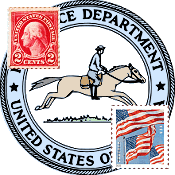History of U.S. Postage Stamp Prices |
||||||||||||||||||||||||||||||||||||||||||||||||||||||||||||||||||||||||||||||||||||||||||||||||||||||||||||||||||||||||||||||||||||||||||||||||||||||||||||||||||||
 Prior to the middle of the 19th century, U.S. Post Office mailing rates were based on the number of sheets in a letter and the distance it was traveling. In 1845, rates were based on the weight of a letter and the distance it was going. Beginning in 1863, domestic letter rates became "uniform," that is, they were based solely on weight, regardless of distance. Benjamin Franklin was appointed as America's first Postmaster General in 1775. The first postage stamps were issued in 1847 According to the Bureau of Labor Statistics' (BLS) Inflation Calculator, the inflation-adjusted price of the 1919 2¢ stamp is 35¢ in 2023 (a 17.5x, or 1650% increase). It is actually 66¢ as of July 9th. That's a 33x (3200%) increase, nearly twice the rate of inflation. Postage rates listed below are in cents.
Table from the U.S. Postal Service
|
||||||||||||||||||||||||||||||||||||||||||||||||||||||||||||||||||||||||||||||||||||||||||||||||||||||||||||||||||||||||||||||||||||||||||||||||||||||||||||||||||||